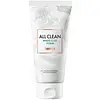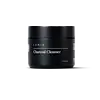What's inside
What's inside
 Key Ingredients
Key Ingredients

 Benefits
Benefits

 Concerns
Concerns

 Ingredients Side-by-side
Ingredients Side-by-side

Water
Skin ConditioningGlycerin
HumectantStearic Acid
CleansingMyristic Acid
CleansingPEG-32
HumectantPotassium Hydroxide
BufferingLauric Acid
CleansingBentonite
AbsorbentPotassium Cocoate
EmulsifyingButylene Glycol
HumectantCocamidopropyl Betaine
CleansingPotassium Cocoyl Glycinate
Glyceryl Stearate
EmollientPEG-100 Stearate
Kaolin
AbrasiveCitrus Aurantium Dulcis Peel Oil
MaskingLavandula Angustifolia Oil
MaskingAmyris Balsamifera Bark Oil
MaskingPelargonium Graveolens Flower Oil
MaskingCocos Nucifera Oil
MaskingCitrus Paradisi Peel Oil
MaskingLitsea Cubeba Fruit Oil
MaskingEucalyptus Globulus Leaf Oil
PerfumingMelaleuca Alternifolia Leaf Oil
AntioxidantMentha Arvensis Leaf Oil
MaskingBoswellia Carterii Oil
MaskingCitrus Aurantium Bergamia Fruit Oil
MaskingJuniperus Mexicana Oil
MaskingMyristica Fragrans Kernel Oil
MaskingTagetes Minuta Flower Oil
MaskingJasminum Officinale Flower/Leaf Extract
MaskingNelumbo Nucifera Flower Extract
Skin ConditioningFreesia Refracta Extract
Skin ConditioningIris Versicolor Extract
EmollientLeontopodium Alpinum Flower/Leaf Extract
Skin ConditioningLilium Candidum Bulb Extract
Skin ConditioningNarcissus Pseudo-Narcissus Flower Extract
Skin ConditioningRose Extract
Skin ConditioningPEG-75
HumectantPolyquaternium-7
Hyaluronic Acid
HumectantHydrolyzed Hyaluronic Acid
HumectantSodium Hyaluronate
HumectantEthylhexylglycerin
Skin ConditioningHydrolyzed Silk
HumectantDisodium EDTA
Sodium Benzoate
MaskingPhenoxyethanol
PreservativeParfum
MaskingWater, Glycerin, Stearic Acid, Myristic Acid, PEG-32, Potassium Hydroxide, Lauric Acid, Bentonite, Potassium Cocoate, Butylene Glycol, Cocamidopropyl Betaine, Potassium Cocoyl Glycinate, Glyceryl Stearate, PEG-100 Stearate, Kaolin, Citrus Aurantium Dulcis Peel Oil, Lavandula Angustifolia Oil, Amyris Balsamifera Bark Oil, Pelargonium Graveolens Flower Oil, Cocos Nucifera Oil, Citrus Paradisi Peel Oil, Litsea Cubeba Fruit Oil, Eucalyptus Globulus Leaf Oil, Melaleuca Alternifolia Leaf Oil, Mentha Arvensis Leaf Oil, Boswellia Carterii Oil, Citrus Aurantium Bergamia Fruit Oil, Juniperus Mexicana Oil, Myristica Fragrans Kernel Oil, Tagetes Minuta Flower Oil, Jasminum Officinale Flower/Leaf Extract, Nelumbo Nucifera Flower Extract, Freesia Refracta Extract, Iris Versicolor Extract, Leontopodium Alpinum Flower/Leaf Extract, Lilium Candidum Bulb Extract, Narcissus Pseudo-Narcissus Flower Extract, Rose Extract, PEG-75, Polyquaternium-7, Hyaluronic Acid, Hydrolyzed Hyaluronic Acid, Sodium Hyaluronate, Ethylhexylglycerin, Hydrolyzed Silk, Disodium EDTA, Sodium Benzoate, Phenoxyethanol, Parfum
Water
Skin ConditioningMyristic Acid
CleansingButylene Glycol
HumectantStearic Acid
CleansingPotassium Hydroxide
BufferingGlycerin
Humectant1,2-Hexanediol
Skin ConditioningCocamide Mea
EmulsifyingCharcoal Powder
AbrasivePotassium Cocoyl Glycinate
Potassium Cocoate
EmulsifyingButyrospermum Parkii Butter
Skin ConditioningSorbitan Olivate
EmulsifyingCitrus Aurantium Bergamia Fruit Oil
MaskingPelargonium Graveolens Flower Oil
MaskingLavandula Angustifolia Oil
MaskingCitrus Medica Peel Oil
Rose Flower Oil
MaskingSantalum Album Oil
MaskingCymbopogon Martini Oil
MaskingBHT
AntioxidantDisodium EDTA
Centella Asiatica Extract
CleansingPolygonum Cuspidatum Root Extract
AntioxidantScutellaria Baicalensis Root Extract
AstringentCamellia Sinensis Leaf Extract
AntimicrobialGlycyrrhiza Glabra Root Extract
BleachingChamomilla Recutita Flower Extract
MaskingRosmarinus Officinalis Leaf Extract
AntimicrobialWater, Myristic Acid, Butylene Glycol, Stearic Acid, Potassium Hydroxide, Glycerin, 1,2-Hexanediol, Cocamide Mea, Charcoal Powder, Potassium Cocoyl Glycinate, Potassium Cocoate, Butyrospermum Parkii Butter, Sorbitan Olivate, Citrus Aurantium Bergamia Fruit Oil, Pelargonium Graveolens Flower Oil, Lavandula Angustifolia Oil, Citrus Medica Peel Oil, Rose Flower Oil, Santalum Album Oil, Cymbopogon Martini Oil, BHT, Disodium EDTA, Centella Asiatica Extract, Polygonum Cuspidatum Root Extract, Scutellaria Baicalensis Root Extract, Camellia Sinensis Leaf Extract, Glycyrrhiza Glabra Root Extract, Chamomilla Recutita Flower Extract, Rosmarinus Officinalis Leaf Extract
 Reviews
Reviews

Ingredients Explained
These ingredients are found in both products.
Ingredients higher up in an ingredient list are typically present in a larger amount.
Butylene Glycol (or BG) is used within cosmetic products for a few different reasons:
Overall, Butylene Glycol is a safe and well-rounded ingredient that works well with other ingredients.
Though this ingredient works well with most skin types, some people with sensitive skin may experience a reaction such as allergic rashes, closed comedones, or itchiness.
Learn more about Butylene GlycolCitrus Aurantium Bergamia Fruit Oil is the oil from the bergamot orange. It is native to Italy.
This ingredient is used to add fragrance to products. It contains limonene, linalool, and linalyl acetate.
The term 'fragrance' is not regulated in many countries. In many cases, it is up to the brand to define this term. For instance, many brands choose to label themselves as "fragrance-free" because they are not using synthetic fragrances. However, their products may still contain ingredients such as essential oils that are considered a fragrance.
When used topically, Citrus Aurantium Bergamia Fruit Oil is a photosensitizer due to its furanocoumarins. Photosensitizers make the skin and eyes much more sensitive to sunlight. Photosensitizers are linked to skin cancer.
However, more cosmetics using Citrus Aurantium Bergamia Fruit Oil are removing the furanocoumarins.
Bergamot oil was also found to have anti-inflammatory, antibacterial and antifungal properties.
Learn more about Citrus Aurantium Bergamia Fruit OilDisodium EDTA plays a role in making products more stable by aiding other preservatives.
It is a chelating agent, meaning it neutralizes metal ions that may be found in a product.
Disodium EDTA is a salt of edetic acid and is found to be safe in cosmetic ingredients.
Learn more about Disodium EDTAGlycerin is already naturally found in your skin. It helps moisturize and protect your skin.
A study from 2016 found glycerin to be more effective as a humectant than AHAs and hyaluronic acid.
As a humectant, it helps the skin stay hydrated by pulling moisture to your skin. The low molecular weight of glycerin allows it to pull moisture into the deeper layers of your skin.
Hydrated skin improves your skin barrier; Your skin barrier helps protect against irritants and bacteria.
Glycerin has also been found to have antimicrobial and antiviral properties. Due to these properties, glycerin is often used in wound and burn treatments.
In cosmetics, glycerin is usually derived from plants such as soybean or palm. However, it can also be sourced from animals, such as tallow or animal fat.
This ingredient is organic, colorless, odorless, and non-toxic.
Glycerin is the name for this ingredient in American English. British English uses Glycerol/Glycerine.
Learn more about GlycerinLavandula Angustifolia Oil is more commonly known as lavender essential oil. It is considered a fragrancing ingredient.
Lavender imparts a famous scent. While the smell is lovely, this ingredient and may sensitize skin in topical products. This is because about 85% of the oil is made up of linalool and linalyl acetate.
When exposed to air, these two compounds become strong allergens. This ingredient exhibits cytotoxicity at low concentrations; amounts of 0.25% have been shown to damage skin cells.
A study from Japan found this ingredient caused lavender sensitivity after widespread exposure.
Lavender essential oil has some antimicrobial, antibacterial, and anti-inflammatory properties. However, the cons of this ingredient may outweight the pros.
More research is needed to confirm lavender essential oil's effects when used in aromatherapy.
Lavandula Angustifolia is known as the English Lavender and famous for creating purple fields in Provence, France.
Learn more about Lavandula Angustifolia OilMyristic Acid is a saturated fatty acid. It is naturally found in milk fat. Other sources include palm oil, coconut oil, and butter fat.
Myristic Acid is an emulsifer and cleanser. As an emulsifer, it stabilizes a product by preventing ingredients from separating. Myristic Acid helps clean your skin by acting as a surfactant. It tends to gather oil and dirt on your skin to be easily rinsed away.
One study from 2021 found Myristic Acid to have anti-inflammatory properties.
Learn more about Myristic AcidPelargonium Graveolens Flower Oil is the pressed oil of the Rose Geranium plant. It is volatile, meaning it evaporates off the skin.
Fragrant components of Rose Geranium include citronellol and geraniol. These may cause allergies and skin-sensitivity. We recommend speaking with a professional if you have any concerns.
The scent of Rose Geranium closely resembles traditional roses.
Learn more about Pelargonium Graveolens Flower OilThis ingredient is the potassium salt of coconut acid. Coconut acid is created by mixing fatty acids from coconut oil.
It is an emulsifier, surfactant, and cleanser. According to a manufacturer, it contains glycerin.
Potassium Cocoyl Glycinate is an amino acid-based surfactant and cleaning agent. This ingredient can be derived from animals or plants. It may also be synthetically created from fatty acids of the coconut and glycine.
Potassium Cocoyl Glycinate is a gentle surfactant. Surfactants help gather the dirt, oil, and other pollutants from your skin to be rinsed away. It is a mild cleanser and naturally produces foam.
Potassium hydroxide is commonly known as caustic potash. It is used to fix the pH of a product or as a cleaning agent in soap. In cleansers, it is used for the saponification of oils.
Sapnification is the process of creating fatty acid metal salts from triglycerides and a strong base. During this process, Potassium Hydroxide is used up and is not present in the final product.
Using high concentrations of Potassium Hydroxide have shown to irritate the skin.
Learn more about Potassium HydroxideStearic Acid is a fatty acid. It is an emollient, emulsifier, and texture enhancer.
As an emollient, stearic acid helps soften skin. It aids the skin's protective barrier by preventing water loss. It also provides a gentle cleansing effect without stripping away natural oils.
Stearic acid may also be used to enhance the texture of products. It can add volume and stabilize ingredients such as water and oil. This can help water and oil ingredients from separating.
Sources of stearic acid include animal or vegetable fats/oils such as coconut or shea. It can be naturally found in butter, cocoa butter, shea butter, vegetable fats, and animal tallow.
This ingredient may not be Malassezia folliculitis, or fungal-acne safe.
Learn more about Stearic AcidWater. It's the most common cosmetic ingredient of all. You'll usually see it at the top of ingredient lists, meaning that it makes up the largest part of the product.
So why is it so popular? Water most often acts as a solvent - this means that it helps dissolve other ingredients into the formulation.
You'll also recognize water as that liquid we all need to stay alive. If you see this, drink a glass of water. Stay hydrated!
Learn more about Water